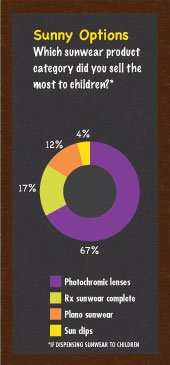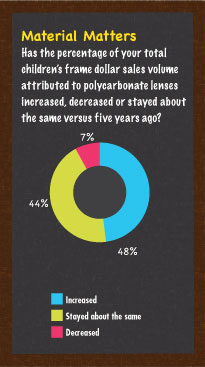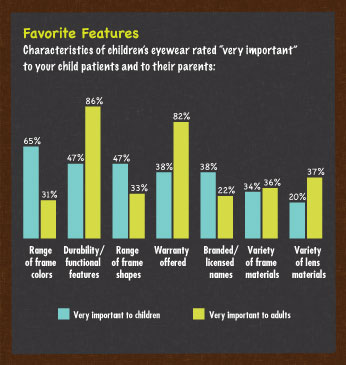
By Gloria Nicola
 Courted by everyone from fashion designers and food manufacturers to giant retailers, kids are the consumers of today… and tomorrow. Their impact on business is super-sized. Selling kids’ eyewear too has grown from a niche to a full-blown business that’s an essential part of the optical market. It’s also demanding with its own distinctive set of challenges.
Courted by everyone from fashion designers and food manufacturers to giant retailers, kids are the consumers of today… and tomorrow. Their impact on business is super-sized. Selling kids’ eyewear too has grown from a niche to a full-blown business that’s an essential part of the optical market. It’s also demanding with its own distinctive set of challenges.
According to respondents of 20/20’s Kids’ Eyewear MarketPulse Survey 2012, the kids’ eyewear business is holding its own, but there have been no major growth spurts in the past year, probably as a result of the still unstable economy. This year’s respondents, who all dispense eyewear to children, report kids from infancy to 14 years represented 15 percent of their customer base in the last year, the same as in the previous two years. Children’s eyewear and related products also accounted for 15 percent of total gross dollar sales for survey participants—this number has remained the same since 2008. Additionally in line with 2011 findings, 31 percent of this year’s respondents again cited an increase in the percentage of total gross sales from children’s products versus five years ago. For 65 percent the percentage of gross sales remained the same. However only 5 percent reported a decrease in percentage of revenue from the kids’ category, significantly down from 11 percent in 2011 and 18 percent in 2010. On the other hand, 39 percent of the 2012 participants said their average children’s complete eyewear retail sale per patient (excluding eye exam fee, but including frames, lenses and lens treatments) has increased in the past year versus five years ago, down from the 47 percent who cited an increase in 2011. For 56 percent the average sale remained the same and for 5 percent there was a decline. In fact the average retail price for a children’s frame, excluding exams and lenses, was $113 down from $129 where it had been from 2009 through 2011. The average retail price for children’s spectacle lenses, which remained steady at $100 between 2007 and 2009 and climbed to $105 in 2010 and $110 in 2011, fell back to $100 this year.
 WHAT’S SELLING
WHAT’S SELLING
With lenses, the material of choice is clearly polycarbonate—undoubtedly as a result of eyecare professionals’ ongoing efforts to inform parents about the necessity of impact-resistant materials. Of those surveyed, 48 percent reported polycarbonate lenses comprised a greater proportion of total children’s eyewear dollars than they did five years ago; only 7 percent reported a decrease. In addition, 43 percent of participants reported a decrease over the past five years in the sale of standard plastic lenses for children. But even these numbers are not as strong as they were in the previous five years when reported increases in polycarbonate lens sales for kids ranged from 52 percent in 2010 to 66 percent in 2007, and decreases in standard plastic lenses ranged from 50 percent in 2011 to 59 percent in 2007.
With frame materials we continue to see a shift toward plastic, following the trend in the adult market. Metal is still generally preferred for children because of its easier adjustability. But plastic has been showing substantial gains, no doubt because kids like the bolder color effects available with plastic. Of those surveyed this year, 59 percent reported an increase in children’s frame dollar sales attributed to plastic materials in the past five years, a slight increase from 57 percent last year and a substantial increase over 47 percent in 2010. Only 17 percent reported an increase in dollar sales from metal frames.
 Another growth area in the children’s market and a very important one is protective sport eyewear—again influenced by several factors including ECPs’ ongoing efforts to inform parents about the necessity of protective eyewear, the increasing interest in sport eyewear among adults and efforts on the part of eyewear manufacturers to offer colorful sport glasses designed specifically for children. The majority of retailers surveyed, 84 percent, reported selling protective sport eyewear to children. Additionally 82 percent said they dispense contact lenses to kids—an option especially for children active in sports.
Another growth area in the children’s market and a very important one is protective sport eyewear—again influenced by several factors including ECPs’ ongoing efforts to inform parents about the necessity of protective eyewear, the increasing interest in sport eyewear among adults and efforts on the part of eyewear manufacturers to offer colorful sport glasses designed specifically for children. The majority of retailers surveyed, 84 percent, reported selling protective sport eyewear to children. Additionally 82 percent said they dispense contact lenses to kids—an option especially for children active in sports.
Although not as dominant as in the adult market, branded names are another category that has impacted the kids’ market. In the past six years, survey respondents have reported branded/licensed products have accounted for anywhere from a high of 33 percent to a low of 25 percent of their total children’s frame sales. This year the number declined to 25 percent from 30 percent in 2011. Twenty-seven percent of the respondents said the percentage of their total children’s frame dollar sale volume attributed to branded/licensed frames was up compared with five years ago. For 7 percent, the frame dollar sale volume stayed the same. Other findings also confirmed branding does play a role in the children’s market. Of those surveyed, 38 percent said name brands were very important to their child patients, down from 44 percent the previous year; an additional 46 percent reported brands were somewhat important. However, only 22 percent cited brands as being of major significance to the parents.
 CHALLENGES
CHALLENGES
An area that would definitely benefit by taking more direction from the adult market is sunwear. Unfortunately despite the necessity of sun protection for every age group, selling sunwear to kids continues to be the number one challenge for ECPs. Indeed 61 percent of respondents cited it as a major challenge, up from 53 percent in 2011. An additional 30 percent viewed it as a minor challenge. The main reason for these negative findings is undoubtedly parents’ reluctance to spend money on eyewear likely to be lost or forgotten. The good news is 82 percent of the participants said they sell sunwear to children, and 89 percent dispense frames with photochromic lenses to kids. In fact photochromics were the favored sun option for children with 67 percent of this year’s respondents reporting it was the sunwear product they sold most to children—no doubt because it doesn’t involve buying another frame and lenses, and also is at lower risk for being lost since the eyewear does not have to be removed when inside. Only 17 percent of the participants indicated Rx sunwear complete was the sun product sold most to kids, followed by plano sunglasses and sun clips at 12 percent and 4 percent, respectively.
 Although dispensing sunwear was the major challenge cited by participants, other challenges specific to the kids’ market exist. Most notably: two generations of customers per visit, sometimes three if grandma comes along—frequently with widely varying tastes and priorities. Of those polled, 35 percent saw matching kids’ tastes with parents’ budget restrictions a major challenge; 49 percent reported it as a minor challenge. Catering effectively to the young teen market was another major challenge reported by 18 percent and a minor challenge for 58 percent. It should be noted optical manufacturers have been taking steps to address this age group with collections that are just grown-up enough to still appeal to young teens. Getting parents and children to agree on what eyewear to purchase was yet another major challenge for 12 percent of the respondents and a minor challenge for an additional 65 percent.
Although dispensing sunwear was the major challenge cited by participants, other challenges specific to the kids’ market exist. Most notably: two generations of customers per visit, sometimes three if grandma comes along—frequently with widely varying tastes and priorities. Of those polled, 35 percent saw matching kids’ tastes with parents’ budget restrictions a major challenge; 49 percent reported it as a minor challenge. Catering effectively to the young teen market was another major challenge reported by 18 percent and a minor challenge for 58 percent. It should be noted optical manufacturers have been taking steps to address this age group with collections that are just grown-up enough to still appeal to young teens. Getting parents and children to agree on what eyewear to purchase was yet another major challenge for 12 percent of the respondents and a minor challenge for an additional 65 percent.
In fact 65 percent of participants reported the major consideration for kids in selecting their eyewear is a broad range of color options. On the other hand, only 31 percent indicated color was very important to the parents. By far the most important factor for parents understandably is durability and functionality cited by 86 percent as very important, closely followed by warranties at 82 percent.
WHAT ECPS WANT
Manufacturers and vendors exert enormous effort in helping ECPs build their kids’ business, primarily by offering an abundance of fun and highly functional products. Check the pages in this issue. And they continue to partner with retailers, offering marketing tools. The most effective method, according to 37 percent of those surveyed, is point-of-purchase materials, followed by special promotions, cited by 33 percent. Although no dramatic changes took place in children’s eyewear in the past year, the kids’ business is still a relatively young business, and like the kids themselves, full of potential. But it’s demanding work—requiring concentrated energy and dedication. And it deserves special attention. It is our future and the future of eyewear. ■
Methodology
20/20’s Kids’ Eyewear MarketPulse Survey 22012 was conducted in April 2012 by Jobson Optical Research’s in-house research staff. The 2012 sample of 211 independent optical retailers, who sell to children as well as other age groups, was derived from the proprietary Jobson Optical Research database. Only the responses of dispensers who sell eyewear to children were included in the report. The 2008, 2009, 2010, 2011 and 2012 studies were conducted online where participants were recruited by e-mail and the questionnaire was completed online. Respondents were offered the chance to enter a drawing to win a $200 American Express gift card as an incentive. The 2007 study was conducted via telephone and no incentive was offered. Six years of data is provided for comparisons where possible.
 —Jennifer Zupnick
—Jennifer Zupnick
Senior Research Analyst
Jobson Optical Research











